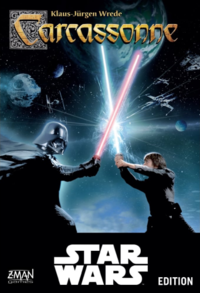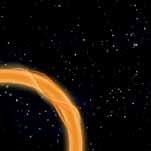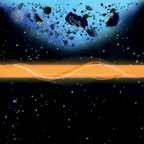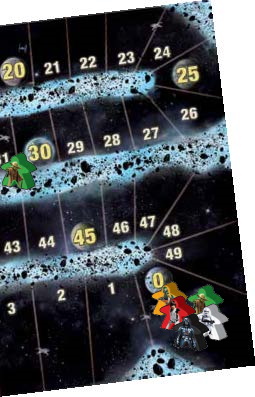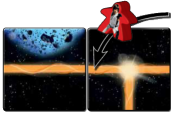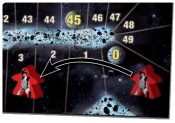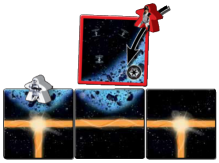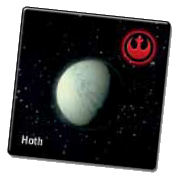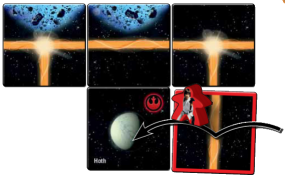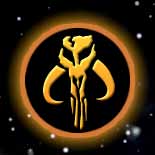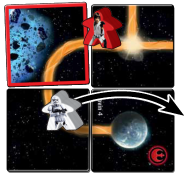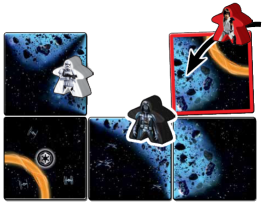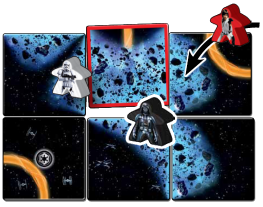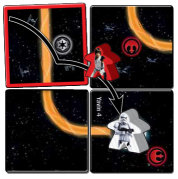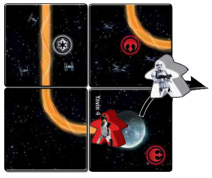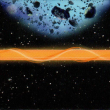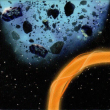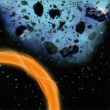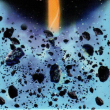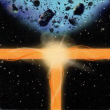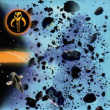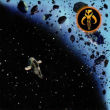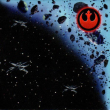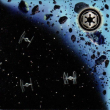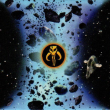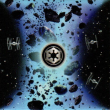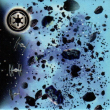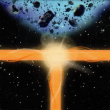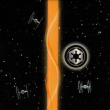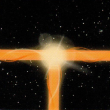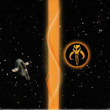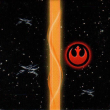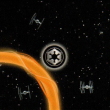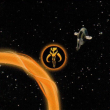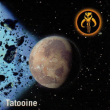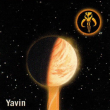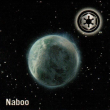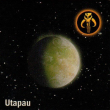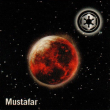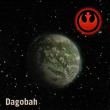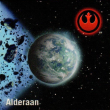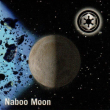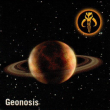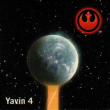Star Wars Base Game
 |
You are reading the rules for this tile design. |  |
| If your tiles look like this, you have regular Carcassonne tiles. |  |
| If your tiles have a different design, then choose a game from Spin-offs. |  |
General Info and Comments
Originally released by Hans im Glück in 2015, Carcassonne: Star Wars is an exciting tile-laying game for 2 to 5 players, ages 8 and up.
Experience the exciting adventures of the Star Wars™ Universe in the enthralling world of Carcassonne!
Exciting duels for dominance in a far-away galaxy are awaiting you. Master the decisive battles and position your troops advantageously on the path to victory.
May the force be with you!
Components and setup
Welcome to Star Wars Carcassonne! In these instructions we will guide you, in a snap, through the easy rules of the game. After briefly reading through this section, you will be ready to show and explain the game to your friends. There will be nothing else standing between you and the enjoyment of Star Wars Carcassonne.
First you need to set up the game. That can be done quickly. While setting up, we will tell you a bit about the parts of the game.
First, let's look at the TILES. The 76 tiles show trading routes, asteroid fields, and planets.
Right now you don't have to worry about the other elements, such as the symbols. We will explain these later.
The reverse sides of all tiles look the same, only the starting tile is orange, so that it can always be distinguished.
You begin setting up by placing the starting tile (the one with the orange reverse side) in the middle of the playing board. Mix the remaining tiles and place them face down on the table in multiple stacks, in such a manner that every player has easy access to them.
Next there is a scoring board as well as 3 red and 3 green dice, which you will place on the edge of the playing board.
Finally, we should take a look at the FIGURES (meeples), and then you will be finished setting up. In this game you will find 30 meeples, 6 pieces each in the colours red, green, black, white and orange.
First you give each player 5 meeples (4 small and 1 large meeple) as well as the corresponding CHARACTER CARD in the desired colour. These will comprise the player's reserve (you also take a colour for yourself, of course). Then you will place the 6th (small) meeple on Field 0 on the scoring board. Place all unused meeples and character cards back in the box.
Object of the game
What is Star Wars Carcassonne about, what is the object of the game? Step by step, all players will place the tiles next to one another. In this manner you will build trading routes, explore asteroid fields, and conquer planets. In the process, you can use your meeples as merchants, explorers, or conquerors. This will earn you points, both during the game and at the end. The final score alone will determine who has the most points and is the winner. Let's get started!
How to play the game
In Star Wars Carcassonne we play in a clockwise direction and the youngest player gets to make the first move. Here, the player who has a turn always performs the actions described below in the order specified. The next player then has a turn, etc. First, we will list the actions and then we will explain them in the following section. We do this using the trading routes, asteroid fields and planets illustrated on the tiles. What are the actions?
4. Calculating points
The trading routes
1. Put your tile in place
The tile that you selected shows 3 trading routes that originate from one intersection. You place it next to the starting tile. Here, you must make sure that at least one side of the tile you selected fits one side of the displayed tile.
2. Using a meeple as a merchant
After you have positioned your tile, you may place a meeple as a merchant on a trading route for this tile. This is only possible, however, if there is no other merchant on this trading route.
The trading route has not been completed yet. For this reason, points will not be calculated (action 4) for now and it will be the next player's turn.
The next player draws a tile and positions it. Since a meeple (your merchant) is already standing on the right-hand side of the intersection, the next player may not place a meeple there. Instead, he positions his meeple as an explorer in the asteroid field of the tile that was put in place just now.
3. Time for battle
You will always take this action when the meeples from several players are standing in one realm (e.g. a trading route). We will explain this later in an additional section.
4. Calculating points
Every time that a trading route is completed on both ends, the score for the trading route will be calculated. Here, the trading route must end at an intersection, on an asteroid field, on a planet, or by meeting itself. Every tile on your trading route earns you 1 point. In addition, there are also 3 different faction symbols (Rebel Alliance, Empire and Bounty Hunters, a more detailed explanation will follow). Every time that you earn points and there are faction symbols in your realm, you will earn 2 additional points for each symbol (no matter which faction you belong to).
The scoring board comes into play now. So you don't have to keep track of your score all the time, you will move your meeple forward on the scoring board instead. You will move your meeple forward on the scoring board by 3 steps.
After each points calculation, you will put the meeples that were included in the calculation back into your reserves.
Later in the game, when you have gone around the scoring board once, you will lay down your meeple to show that you have already accumulated 50 points.
Perfect, now you have understood the most important rules of the game. Let's take a look now at the other realms.
The asteroid fields
1. Put your tile in place
2. Using a meeple as an explorer
Next, you will check to see if a meeple is already placed on the asteroid field. Since there are none, you can place a meeple as an explorer.
3. Time for battle
When meeples from different players are standing in one asteroid field, a battle will always ensue.
4. Calculating points
We will now fast forward a bit, and will assume that you selected this tile (with red border) in the next round. You can place it on your asteroid field.
The realm (in this case the asteroid field) will thus be completed. Every time that an asteroid field is exclusively surrounded by the cosmos and offers no more openings, it will be considered completed. Since you have a meeple in the asteroid field, you will now calculate the value of this asteroid field and receive points as a result.
Every tile with an asteroid field in a completed asteroid field counts for 2 points. In addition, each faction symbol in a completed asteroid field counts as 2 additional points. The type of faction symbol doesn't matter.
The planets
1. Put your tile in place
Like before, you will first draw a tile to place on the board. Here, too, the tile must fit correctly. A planet is always found in the middle of the tile. Trading routes and asteroid fields can also be found, however, on some planet tiles. If you wish to position your tile, you must pay attention (as always) to the tile's borders.
2. Using a meeple as a conqueror
You may also place meeples, which we call conquerors, on planets. You take these from your reserve and place them exactly in the middle of the planet.
There is one more way to use a conqueror on a planet. When you place your tile on one of the 8 free fields surrounding a planet. In other words: if you place a tile next to a planet (next to one of its sides, or even next to it diagonally), you may place one of your meeples either on the placed card (as usual) or directly on the planet. Unlike the trading route or the asteroid field, you may also place a meeple on a planet that is already occupied. This is an exception in Carcassonne Star Wars and will be explained in greater detail later.
3. Time for battle
When meeples from different players are positioned on one single planet, a battle will always ensue.
4. Calculating points
You calculate the score for a planet as soon as it is surrounded by tiles on all sides. Here, each tile (including the planet itself) counts as 1 point. In addition, the faction symbol on the planet counts as 2 additional points. The type of faction symbol doesn't matter. The faction symbols on the 8 tiles positioned around the planet will not be counted, since they are counted in the other realms (trading routes or asteroid fields).
Multiple meeples in one realm
Placing meeples on trading routes and asteroid fields that are already occupied by other meeples is not allowed. However, it is possible that more than one meeple ends up on the same realm due to a "merging" of the realms, or when meeples are placed on an already-occupied planet. In Star Wars Carcassonne, however, only meeples of the same colour may occupy the same realm. When realms with different-coloured meeples are merged, a battle will ensue and will be fought out with dice.
3. Time for battle
FACTIONS: Together with your meeple, you obtained a character card with an illustration of a faction symbol. These are the three different factions. These symbols are also illustrated on the tiles. [1]
WHEN DOES A BATTLE TAKE PLACE? As soon as multiple meeples from different players stand in one realm (trading route, asteroid field, or planet), a battle will take place immediately. The battle will always be carried out as the 3rd action, before the calculation of points. Even if the player who merged the realms is not involved in the battle.
HOW MANY DICE IS A PLAYER GIVEN? For every one of your small meeples participating in the battle, you will receive 1 die. If you fight with your large meeple, you will receive 2 dice for it. If one or more symbols from your faction belong to the contested realm, you will receive 1 additional die. No matter how many of your meeples or symbols are involved in a battle, you can only receive a maximum of 3 dice for the battle.
THE BATTLE: All players participating in the battle roll their dice. To determine who has won the battle, only the dice with the highest value for each player will be considered. The other dice become irrelevant. The person who rolled the highest number wins.
TIE: Each time that the highest number is tied, all players who are part of the tie will receive 1 point. The players who rolled lower numbers will withdraw from the battle. The players who tied will roll the dice once again, until a new result is obtained.
LOSS: If a player loses the battle (even if others are still in combat), he will withdraw his meeple and place it back in his reserve. He will receive 1 point for every die that he rolled. The winner will leave his meeple standing (or will calculate the score for the realm, in case it was completed).
We will now learn how battle are initiated in the individual realms and how they can be fought.
The battle for trading routes
- The tile that you have drawn could extend the trading route. Since another player's merchant is already placed on the trading route, however, you cannot place one of your own meeples there. You therefore decide to place your tile in a manner that does not connect the trading routes.
- In one of the next rounds you place this tile on the open trading route. You cannot place any more meeples on the trading route itself, but you may on the asteroid field or the planet. After placement, a battle for the now-linked trading routes will ensue.
Both the white player and you will take one die each. (The Rebel Alliance symbol next to the planet does not earn you any extra dice because it only counts for the planet.) As a member of the Rebel Alliance faction you take the red dice; the Empire takes the green dice.
You roll a 6 and white rolls a 1. White lost and must withdraw his meeple and place it back in his reserve. He will receive 1 point since he fought with 1 die. Since the trading route is now completed, a score is calculated, for which you receive 4 points.
The battle for asteroid fields
- In the hope of being able to snatch the asteroid field away from black and white, you lay down the asteroid field tile and position one of your meeples as an explorer. This is allowed since the asteroid field is not linked to any other asteroid field on which there is already an explorer. If you draw the appropriate tile in a later move, you can attack the asteroid fields of black and white with your explorer.
- You are lucky and, in a later move, you draw the right tile to merge all tiles into one large, completed asteroid field. A battle ensues.
Both the white player and you will take one die each. (The Rebel Alliance symbol next to the planet does not earn you any extra dice because it only counts for the planet.) As a member of the Rebel Alliance faction you take the red dice; the Empire takes the green dice.
Since you have 1 meeple and the symbol of your faction appears on one of the asteroid fields, you may use a total of 2 dice. White may use 1 die for 1 meeple. Black has one large meeple and therefore may use 2 dice. The faction symbol on the trading route does not belong to the asteroid field. Therefore, black and white will not receive any additional dice.
1st throw:
White rolls a 3 and is thus lower than you or black. White loses and withdraws his meeple. Since white had 1 die in play, he receives 1 point. There is a tie between you and black since you both rolled a 4. You both receive 1 point and roll the dice again.
2nd throw:
By rolling a 6, black gets the highest number and wins the battle. You lose and remove your meeple. Since you used 2 dice, you receive 2 points. The asteroid field is now completed. Black receives 12 points for this field (5 tiles are worth 2 points each, the faction symbol is worth another 2 points). After the points calculation, black withdraws his meeple.
The battle for planets
The fight for dominance of planets plays a special part in Star Wars Carcassonne; thus, a player can also attack a planet directly. As already mentioned, you may place a conqueror on a planet if you place a tile on one of the 8 free fields surrounding a planet. This is also allowed when a meeple from another player already stands on this planet.
Then you can decide whether you want to make use of the tile's actual function (as a trading route, asteroid field or planet), or attack the occupied planet.
Here, you will also receive dice in accordance with the same rules: 1 die for each small meeple, 2 for a large meeple, and 1 die for your own faction symbol on the planet. If faction symbols are illustrated on the 8 tiles surrounding the planet, this will have no significance regarding such battle for the planet. These symbols do not count toward the planet's value. Here, too, players may use a maximum of 3 dice in battle.
You place the tile with the trading route within the 8 fields surrounding the planet. Instead of using the meeple as a merchant on the trading route, you attack white's large meeple which is on the planet. You will receive 1 additional die for your faction symbol on the planet. Thus, you may attack with 2 dice.
White also receives 2 dice since he is fighting with his large meeple. None of the faction symbols on the tiles with the trading routes will earn you any additional dice. Only the symbol on the planet counts.
1st throw:
In the first throw, you both rolled a 5 as the highest number. You are tied. As a result, you each earn 1 point. Then you will roll the dice again.
2nd throw:
Your 5 beat the whiter player's 4. White withdraws his meeple. Since he had 2 dice in play, he receives 2 points. You place your meeple on the planet you have just conquered, and it is now the next player's turn.
That's it. Now you know the most important rules and you can play Star Wars Carcassonne. We will now summarize the important parts once again, and will mention a couple of small details that you should know.
Summary
1. Putting your tile in place
- The tile that you have drawn must always be placed in such a manner that it fits next to one displayed tile, at least.
- In the very rare case that you can't position your tile anywhere, return the tile to the box and draw a new one. [2]
2. Positioning a meeple
- You can only position a meeple on the tile that you have just put in place.
- You must make sure that no other meeple is standing in this area.
- If you place your tile next to a planet, however, you may then attack the neighboring planet and position your meeple on this planet (even if another meeple is already there).
3. Time for battle
- In a battle between 3 or more different-coloured meeples, all players will roll the dice at the same time. If you don't have enough dice, you will roll the dice one after another and take note of the results.[3] In the case of a tie between 2 or more players who rolled the highest numbers, those players who rolled lower numbers will withdraw from the battle.
- In this game, it is possible that players from the same faction may battle one another.
4. Calculating points
- A trading route will always be completed when both ends meet in an intersection, in an asteroid field, in a planet, or they meet one another. Every trading route tile earns you 1 point.
- An asteroid field is always completed when it is no longer possible to place an additional tile in conformity with the rules, and it offers no more openings. Every asteroid field tile will earn you 2 points.
- In addition, you earn 2 points for every faction symbol (regardless of which faction).
- A planet is always completed when it is completely surrounded by 8 tiles. Every planet then earns you 11 points (9 points for the tiles and 2 points for the planet's faction symbol).
- Points are always calculated at the end of a move. Here, all players who have placed meeples in completed realms may earn points.
- After every points calculation, each player withdraws the meeple(s) for which he earned points.
End of game and final calculation
Unfortunately, Star Wars Carcassonne must come to an end. The good news is that we can now determine a winner. The game ends as soon as one player cannot draw or play any more tiles. Next, a final calculation is carried out and the winner determined.
As soon as the game ends, there are points remaining for all realms in which there are meeples:
- Every trading route earns 1 point for every trading route tile, exactly as during the game.
- Every asteroid field earns 1 point for every tile. Only half, in comparison.
- Every planet earns 1 point and another additional point for every tile surrounding it.
- In each realm (trading routes, asteroid fields, and planets), every faction symbol earns 2 points.

- Final score, asteroid fields: Green earns 5 points (3 tiles + 1 faction symbol) for the large asteroid field. Black earns 1 point (1 tile).
- Final score, planet: Orange earns 6 points for the non-completed planet (4 points for the surrounding tiles and the planet tile + 2 points for the faction symbol).
- Final score, asteroid field: White earns 2 points (2 tiles) for the open asteroid field.
- Final score, trading route: For the open trading route, red earns 3 points (3 tiles).
As soon as you have entered the final calculation into the scoring board, the player with the most points will be the winner of your first Star Wars Carcassonne party. Congratulations!
Team variations — may the force be with you
If you play Star Wars Carcassonne with 4 players, you can also play the game in teams. In this case, the players sitting diagonally from each other would form a team, so that the players of the different factions can alternate having turns. The figures are distributed as follows:
- The players in the Rebel Alliance team receive the red and green meeples.
- The players in the Empire team receive the black and white meeples.
Since the players in a team collect point jointly, you can only place one meeple per team on the scoring board. The extra meeple in the other colour will be placed back in the box.
The players in a team may never battle each other. A battle will only take place when meeples from different factions stand on the same realm. During the battle, only one player per team will roll the dice. He may use 1 die for each meeple in his faction. As usual, he will obtain additional dice for a large meeple and for his own faction symbol. Teams may only combat with a maximum of 3 dice per team, however. The course of the game is identical to that of a normal game, otherwise.
Tile Reference
Footnotes
For Icons explanation and licensing please visit Icons page.
- ↑
 The faction symbols are independent from the planets shown on the tiles and relate to a separate element of gameplay.
The faction symbols are independent from the planets shown on the tiles and relate to a separate element of gameplay.
- ↑
 The rules by ZMG altered this sentence at follows:
The rules by ZMG altered this sentence at follows:
"In the very rare case that you can't position your tile anywhere, put your tile back in the stack and draw a new one." - ↑
 Some players have purchased additional dice sets from online retailers so that each player has their own set which matches their player colour.
Some players have purchased additional dice sets from online retailers so that each player has their own set which matches their player colour.
